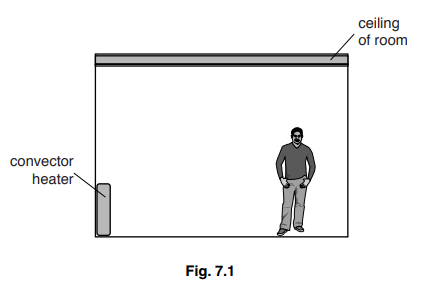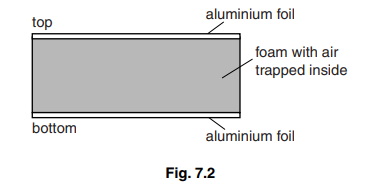Question
Fig. 7.1 shows a room with a heater.

(a) The temperature in the room is hottest near to the ceiling. Explain why.
(b) The ceiling of the room is made from an insulating material as shown in Fig. 7.2.

Explain how this reduces the transfer of thermal energy through the ceiling.
Answer/Explanation
Answer:
(a) any two from:
• hot air expands /particles move (further) apart
• hot air less dense
• less dense air rises
(b) any four from:
• aluminium/ foil (on bottom) is a good reflector
• infrared/radiation reflected back into room
• (trapped) air is a good insulator/ poor conductor
• (insulation) reduces heat lost by conduction
• foam reduces convection currents / prevents air moving
• (air cannot move so) prevents heat loss by convection
• aluminium/ foil (on top) is a poor emitter (so reduces radiation into space above ceiling)
Question
A scientist finds that the temperature of the water at the bottom of waterfalls is greater than the temperature of the water at the tops of those waterfalls.
(a) (i) State the type of energy that falling water has because of its motion.
(ii) In one waterfall, the water falls 300 m.
Calculate the decrease in the gravitational potential energy (g.p.e.) of 1.0 kg of
water as it falls through this distance.
decrease in g.p.e. =
(iii) Assume that the increase in internal energy of the 1.0 kg of water is equal to its decrease in g.p.e.
Calculate the rise in temperature of the water. The specific heat capacity of water is 4200 J / (kg °C).
rise in temperature =
(iv) Suggest a reason why the actual increase in temperature of the water is less than the value calculated in (a)(iii).
(b) State why the thermometer used to measure the temperature of the water in the scientist’s experiment required a high sensitivity.
Answer/Explanation
Answer:
(a) (i) Kinetic
(ii) (GPE=) mgh OR 1.0 × 10 × 300
3000 J
(iii) Q = mcΔθ in any form OR Q÷mc OR 3000÷[(1.0×)4200]
0.71 °C
(iv) Energy used to heat (via air resistance) / Heat lost to surroundings
OR Energy retained as KE of water (at bottom of waterfall)
OR Sound (energy) produced.
(b) Temperature change/difference is (very) small
